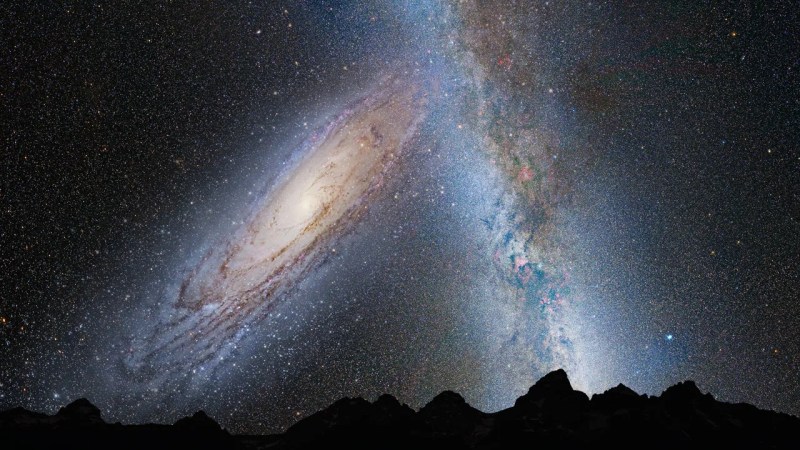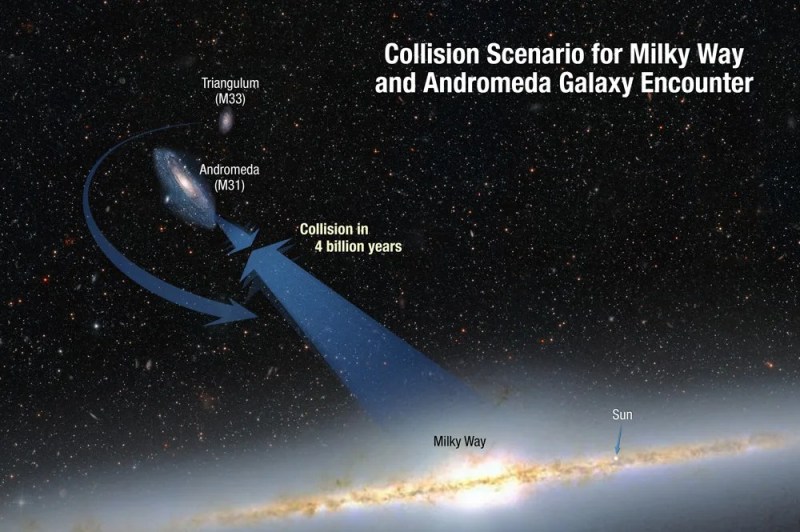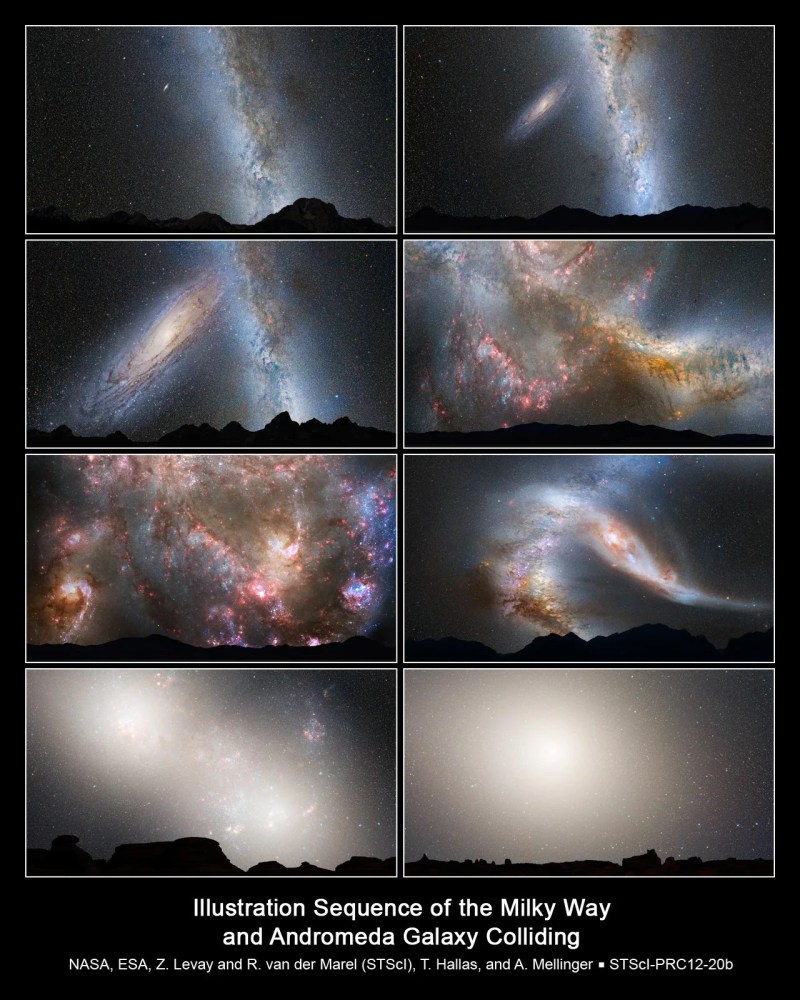Nicht weit weg, bloß 4 Milliarden Jahre Reisezeit, ist eine Galaxis mit dem Namen Andromeda.
Andromeda ist heute 2,5 Millionen Lichtjahre entfernt. Das Bild zeigt, wie es ausschaut, wenn die Andromeda kurz vor unserer Milchstraße ist:

größer:
https://science.nasa.gov/wp-content/uploads/2023/04/654242main_p1220b3k-jpg.webp?w=2048&format=webpEin bißchen groß, aber das Ding ist schließlich eine ganze Galaxis.
Die Nasa schreibt zu diesem Bild:
[*quote*]
This illustration shows a stage in the predicted merger between our Milky Way galaxy and the neighboring Andromeda galaxy, as it will unfold over the next several billion years. In this image, representing Earth's night sky in 3.75 billion years, Andromeda (left) fills the field of view and begins to distort the Milky Way with tidal pull.
NASA; ESA; Z. Levay and R. van der Marel, STScI; T. Hallas; and A. Mellinger
[*/quote*]
Die Andromeda kommt zu Besuch. In rund 4 Milliarden Jahren. Das konnte durch Messungen der Sonde "Hubble" herausgefunden werden. Wann? In 2012.
Seit 2012 wurde immer wieder über die Kollision der beiden Galaxien geschrieben. Das folgende Beweisstück stammt von der Nasa, Soweit ich erkennen kann, ist das die erste Meldung der Nasa über die Kollision. Das Bild und die Beschreibung sind in eben dieser Webseite der Nasa.
https://science.nasa.gov/missions/hubble/nasas-hubble-shows-milky-way-is-destined-for-head-on-collision[*quote*]
NASA
NASA’s Hubble Shows Milky Way is Destined for Head-On CollisionNASA Hubble Mission Team
Goddard Space Flight Center
May 31, 2012
Article
NASA astronomers announced Thursday they can now predict with certainty the next major cosmic event to affect our galaxy, sun, and solar system: the titanic collision of our Milky Way galaxy with the neighboring Andromeda galaxy.
The Milky Way is destined to get a major makeover during the encounter, which is predicted to happen four billion years from now. It is likely the sun will be flung into a new region of our galaxy, but our Earth and solar system are in no danger of being destroyed.

illustration of merging galaxies in night sky with rocky landscape silhouette in foreground
This illustration shows a stage in the predicted merger between our Milky Way galaxy and the neighboring Andromeda galaxy, as it will unfold over the next several billion years. In this image, representing Earth's night sky in 3.75 billion years, Andromeda (left) fills the field of view and begins to distort the Milky Way with tidal pull.
NASA; ESA; Z. Levay and R. van der Marel, STScI; T. Hallas; and A. Mellinger
"Our findings are statistically consistent with a head-on collision between the Andromeda galaxy and our Milky Way galaxy," said Roeland van der Marel of the Space Telescope Science Institute (STScI) in Baltimore.
The solution came through painstaking NASA Hubble Space Telescope measurements of the motion of Andromeda, which also is known as M31. The galaxy is now 2.5 million light-years away, but it is inexorably falling toward the Milky Way under the mutual pull of gravity between the two galaxies and the invisible dark matter that surrounds them both.
This animation depicts the collision between our Milky Way galaxy and the Andromeda galaxy. Hubble Space Telescope observations indicate that the two galaxies, pulled together by their mutual gravity, will crash together about 4 billion years from now. Around 6 billion years from now, the two galaxies will merge to form a single galaxy. The video also shows the Triangulum galaxy, which will join in the collision and perhaps later merge with the Andromeda/Milky Way pair. -
Download video (45 MB mp4)
https://www.nasa.gov/mp4/654254main_v1220j_H264l.mp4Visualization Credit: NASA; ESA; and F. Summers, STScI | Simulation Credit: NASA; ESA; G. Besla, Columbia University; and R. van der Marel, STScI
[VIDEO AT YOUTUBE:
https://www.youtube.com/watch?v=fMNlt2FnHDg ]
"After nearly a century of speculation about the future destiny of Andromeda and our Milky Way, we at last have a clear picture of how events will unfold over the coming billions of years," said Sangmo Tony Sohn of STScI.
The scenario is like a baseball batter watching an oncoming fastball. Although Andromeda is approaching us more than 2,000 times faster, it will take 4 billion years before the strike.
Computer simulations derived from Hubble's data show that it will take an additional two billion years after the encounter for the interacting galaxies to completely merge under the tug of gravity and reshape into a single elliptical galaxy similar to the kind commonly seen in the local universe.
Although the galaxies will plow into each other, stars inside each galaxy are so far apart that they will not collide with other stars during the encounter. However, the stars will be thrown into different orbits around the new galactic center. Simulations show that our solar system will probably be tossed much farther from the galactic core than it is today.
To make matters more complicated, M31's small companion, the Triangulum galaxy, M33, will join in the collision and perhaps later merge with the M31/Milky Way pair. There is a small chance that M33 will hit the Milky Way first.

[größer:
https://science.nasa.gov/wp-content/uploads/2023/04/654284main_i1220bw-jpg.webp?w=2048&format=webp ]
illustration showing trajectories of galactic merger between Andromeda and Milky Way
This illustration shows the collision paths of our Milky Way galaxy and the Andromeda galaxy. The galaxies are moving toward each other under the inexorable pull of gravity between them. Also shown is a smaller galaxy, Triangulum, which may be part of the smashup.
NASA; ESA; A. Feild and R. van der Marel, STScI
The universe is expanding and accelerating, and collisions between galaxies in close proximity to each other still happen because they are bound by the gravity of the dark matter surrounding them. The Hubble Space Telescope's deep views of the universe show such encounters between galaxies were more common in the past when the universe was smaller.
A century ago astronomers did not realize that M31 was a separate galaxy far beyond the stars of the Milky Way. Edwin Hubble measured its vast distance by uncovering a variable star that served as a "milepost marker."
Hubble went on to discover the expanding universe where galaxies are rushing away from us, but it has long been known that M31 is moving toward the Milky Way at about 250,000 miles per hour. That is fast enough to travel from here to the moon in one hour. The measurement was made using the Doppler effect, which is a change in frequency and wavelength of waves produced by a moving source relative to an observer, to measure how starlight in the galaxy has been compressed by Andromeda's motion toward us.
Previously, it was unknown whether the far-future encounter will be a miss, glancing blow, or head-on smashup. This depends on M31's tangential motion. Until now, astronomers had not been able to measure M31's sideways motion in the sky, despite attempts dating back more than a century. The Hubble Space Telescope team, led by van der Marel, conducted extraordinarily precise observations of the sideways motion of M31 that remove any doubt that it is destined to collide and merge with the Milky Way.
"This was accomplished by repeatedly observing select regions of the galaxy over a five- to seven-year period," said Jay Anderson of STScI.
"In the worst-case-scenario simulation, M31 slams into the Milky Way head-on and the stars are all scattered into different orbits," said Gurtina Besla of Columbia University in New York, N.Y. "The stellar populations of both galaxies are jostled, and the Milky Way loses its flattened pancake shape with most of the stars on nearly circular orbits. The galaxies' cores merge, and the stars settle into randomized orbits to create an elliptical-shaped galaxy."

[größer:
https://science.nasa.gov/wp-content/uploads/2023/04/654291main_p1220bk-jpg.webp?w=2048&format=webp ]
eight images showing steps in merger between Milky Way and Andromeda galaxies
NASA; ESA; Z. Levay and R. van der Marel, STScI; T. Hallas, and A. Mellinger
This series of photo illustrations shows the predicted merger between our Milky Way galaxy and the neighboring Andromeda galaxy.
First Row, Left: Present day.
First Row, Right: In 2 billion years the disk of the approaching Andromeda galaxy is noticeably larger.
Second Row, Left: In 3.75 billion years Andromeda fills the field of view.
Second Row, Right: In 3.85 billion years the sky is ablaze with new star formation.
Third Row, Left: In 3.9 billion years, star formation continues.
Third Row, Right: In 4 billion years Andromeda is tidally stretched and the Milky Way becomes warped.
Fourth Row, Left: In 5.1 billion years the cores of the Milky Way and Andromeda appear as a pair of bright lobes.
Fourth Row, Right: In 7 billion years the merged galaxies form a huge elliptical galaxy, its bright core dominating the nighttime sky.
The space shuttle servicing missions to Hubble upgraded it with ever more-powerful cameras, which have given astronomers a long-enough time baseline to make the critical measurements needed to nail down M31's motion. The Hubble observations and the consequences of the merger are reported in three papers that will appear in an upcoming issue of the Astrophysical Journal.
Details
Last Updated
Nov 20, 2023
Editor
Page Last Updated:
2 months ago
Page Editor:
SMD Content Editors
Responsible NASA Official for Science:
Dana Bolles
[*/quote*]
Soweit ist das alles klar und verständlich: Da draußen ist eine Galaxis, die auf uns zurast und in 4 Milliarden Jahren in unsere Milchstraße kracht.
Wie Einschläge von Himmelskörpern aussehen, wissen wir von Mars und Mond: Das gibt große Löcher und heißes Material fliegt quer durch die Landschaft. Wenn es etwas größer wird, dann kann auch schon mal ein Mond entstehen. So wie unser Mond. Wenn ein Planet belebt ist und auch schon etwas Kleineres herunterkracht, dann "Adios, ihr lieben Saurier." Vor 66 Millionen Jahren hat es die Saurier weggeputzt, so ein kleines Abstürzchen. In Südamerika ein heftiger Einschlag, eine Feuerwalze um die Erde herum, und so weiter. Ist inzwischen alles bekannt. Die Spuren kann man auf der ganzen Erde in den geologischen Ablagerungen sehen in der Schicht mit Iridium.
Auch Bayern blieb nicht verschont:
[*quote*]
Wissenschaft
Aussterben der Dinosaurier: Neue Erkenntnisse durch Fund in BayernEin Asteroideneinschlag vor etwa 66 Millionen Jahren sorgte vermutlich für ein Massensterben der Dinosaurier. Nun stützt ein geologischer Fund in Deutschland die Hypothese, dass Vulkanismus die Effekte des Himmelskörpers verstärkte.
Von Marina Weishaupt
Veröffentlicht am 14. Juni 2022, 11:42 MESZ
Viele Jahre Kälte und Dunkelheit folgten auf den Asteroideneinschlag, der vor 66 Millionen Jahren vermutlich die Dinosaurier für immer auslöschte. Doch die Annahme, dass dieser nicht der alleinige Grund für das weitreichende Massensterben war, wird nun von einem weiteren geologischen Fund bekräftigt – und das nicht in Lateinamerika, wo der Asteroid auf die Erde prallte, sondern in Bayern.
Entlang einer beinahe senkrechten Gesteinswand im Wasserfallgraben des Lattengebirges bei Bad Reichenhall stießen Geologen des Landesamts für Umwelt (LfU) auf eine dünne Schicht von weiß-beigen Ablagerungen. Laut Roland Eichhorn, Leiter des LfU, stützt dieser Fund die Hypothese, dass die Erde vor 66 Millionen Jahren gleich von zwei zusammenhängenden und einschneidenden Ereignissen erschüttert wurde: Dem Asteroideneinschlag mit extremen Druckwellen, die über die Erde fegten, sowie einen enormen Vulkanismus.
[...]
[*/quote*]
weiterlesen:
https://www.nationalgeographic.de/wissenschaft/2022/06/aussterben-der-dinosaurier-neue-erkenntnisse-durch-fund-in-bayernAlles ganz einfach, alles logisch, alles klar und deutlich.
ZU DEUTLICH! Ja, viel zu deutlich! Schon das Wort "Kollision" ist ja sowas von aggressiv! Das muß verboten werden! Sprachnazis in den USA sind dieser höchstgradig durchgeknallten Ansicht und wollen die Geschichte umschreiben.
Das folgende Beweisstück ist auch im Web-Archive gefrostet:
https://web.archive.org/web/20240105062323/https://www.scientificamerican.com/article/the-language-of-astronomy-is-needlessly-violent-and-inaccurate/https://www.scientificamerican.com/article/the-language-of-astronomy-is-needlessly-violent-and-inaccurate/[*quote*]
Scientific American
Opinion
January 4, 2024
The Language of Astronomy Is Needlessly Violent and InaccurateAstronomy is beautiful and elegant. The language we use to describe its processes is anything but
By Juan P. Madrid
This summer, a team of students and I were enjoying breathtaking views of the night sky while we collected data using telescopes at the McDonald Observatory in West Texas. One night, when we were outside on a telescope catwalk between the screams of a mountain lion, one of my students amazed me with her interpretation of the fate of Andromeda, the galaxy closest to our Milky Way. In describing how these two galaxies will merge a few billion years from now, she said they will experience “a giant galactic hug.”
The kindness, but also the accuracy, of the language my student used was in sharp contrast to the standard description we use in astronomy to explain the final destiny of Andromeda and the Milky Way: “a collision.” But as astronomers have predicted, when Andromeda and the Milky Way finally meet, their stars will entwine and create a larger cosmic structure, a process that is more creating than destroying, which is what we envision when we use the term collision. A galactic hug is scientifically truthful, and it’s led me to believe that astronomers should reconsider the language we use.
For instance, in galaxy evolution we invoke imagery strikingly similar to what you would expect if you were eavesdropping on Hannibal Lecter: words like cannibalism, harassment, starvation, strangulation, stripping or suffocation. There is a rather long list of foul analogies that have entered, and are now entrenched, in the lexicon of professional astronomy. We have grown accustomed to this violent language and as a community, we seldom question or reflect on its use.
Strangulation is a particularly cringeworthy term in astronomy, referring to the decline of the number of stars born in some types of galaxies. This is a vicious crime where most often the victim is a woman; the perpetrator, a man. Yet, we use this word mindlessly to describe a slow astronomical process that takes millions of years. Under certain conditions, some galaxies use up or lose the gas that is the primordial ingredient to form stars. When that happens, galaxies make new stars at a lower rate. But these galaxies do not die or suffer great harm. They will continue to shine and will live their natural evolution.
This is but one of many examples of violent language in our field that actually describes something gradual, slow and perhaps even gentle. Of course, sometimes powerful language is an accurate reflection of what’s happening—a supernova “explosion,” for instance, describes when a star detonates in a mighty blast at the end of its life, enriching the universe with brand new materials. Terms like this need no revision. But in many cases, they’re needlessly vicious and promote inaccurate connotations.
To shift toward more welcoming and truthful language in astronomy, scientific journals can push to change the currently accepted language. The referee, or the scientific editor, can ask the authors to consider more appropriate descriptions of the physical processes involved. Referees, editors and editorial boards can step up to enforce scientific accuracy and stop the use of violent, misogynistic language that is now pervasive. This is a call for scientific precision. The use of hypercharged words in our field ignores the fact that this violent imagery can trigger distress in colleagues who might have been victims of violence.
As authors, we are responsible for the language that we use when we write our papers. We can make a conscious choice and use more factual language. We often ask colleagues to proofread our papers and to look for typos or glaring mistakes. We can engage a reader with different sensitivities, a different gender or ethnicity, and ask for feedback on the terms that we use. This type of conscious engagement with colleagues with different backgrounds can only be beneficial.
As astronomers, we must strive to create a more inclusive and diverse community that reflects the composition of our society. Valuable efforts to provide opportunities for women and minorities to succeed in astronomy have been created. However, by many metrics, the progress made towards gender equality and true diversity has been painfully slow.
We must listen to the new generation of astronomers. My student showed me that while some astronomical processes can be intense, the universe revealed through astronomy provides us with the most fascinating sights known to humankind. Like many other young scientists, she thinks that when we explain astronomical phenomena with wording and phrases that share our excitement and appreciation, it also encourages others to join in and wonder what else we can discover together.
The universe is beautiful, elegant and ever-changing. Astronomy would be wise to follow its lead.
This is an opinion and analysis article, and the views expressed by the author or authors are not necessarily those of Scientific American.
Rights & Permissions
Juan P. Madrid is an assistant professor in the department of physics and astronomy at the University of Texas Rio Grande Valley.
[...]
© 2024 SCIENTIFIC AMERICAN, A DIVISION OF SPRINGER NATURE AMERICA, INC.
ALL RIGHTS RESERVED.
[*/quote*]
Nicht bloß ein Kracher, der Saurier auslöscht, sondern Milliarden Kracher, die die gesamte Milchstraße UND die Andromeda zu Brei schießen. Im oben angegebenen Video der Nasa kann man das Inferno aus sicherer Entfernung sehen. Unbeschreibliche Gewalt löscht alles in 2 Galaxien aus.
Das ist Gewalt, verdammt nochmal!
Aber die Sprachnazis wollen am Daumen lutschen...

 Author
Topic: Die Vernichtung der Astronomie durch Ideologie-Kretins (Read 164 times)
Author
Topic: Die Vernichtung der Astronomie durch Ideologie-Kretins (Read 164 times)
